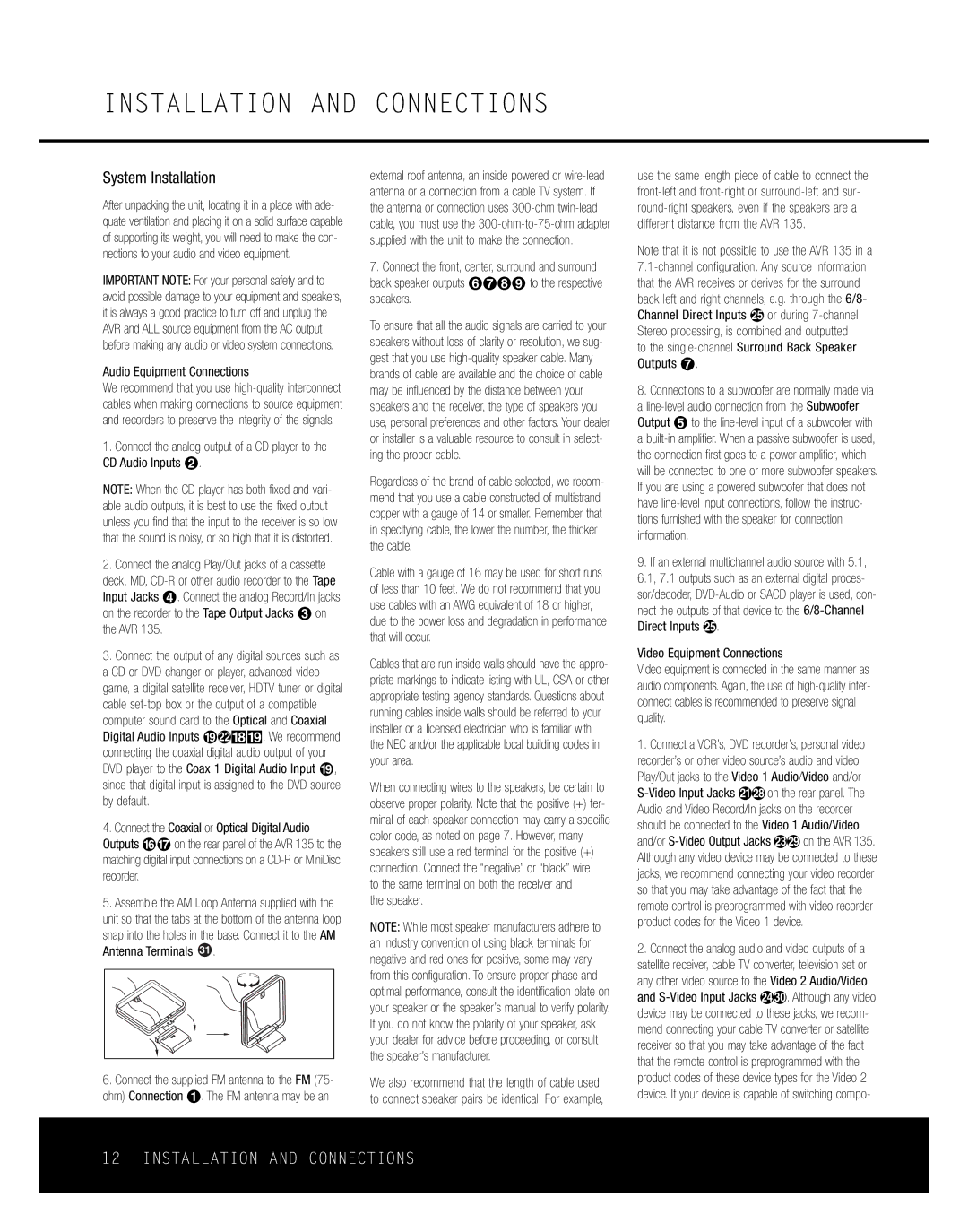
INSTALLATION AND CONNECTIONS
System Installation
After unpacking the unit, locating it in a place with ade- quate ventilation and placing it on a solid surface capable of supporting its weight, you will need to make the con- nections to your audio and video equipment.
IMPORTANT NOTE: For your personal safety and to avoid possible damage to your equipment and speakers, it is always a good practice to turn off and unplug the AVR and ALL source equipment from the AC output before making any audio or video system connections.
Audio Equipment Connections
We recommend that you use
1.Connect the analog output of a CD player to the CD Audio Inputs ™.
NOTE: When the CD player has both fixed and vari- able audio outputs, it is best to use the fixed output unless you find that the input to the receiver is so low that the sound is noisy, or so high that it is distorted.
2.Connect the analog Play/Out jacks of a cassette deck, MD,
3.Connect the output of any digital sources such as a CD or DVD changer or player, advanced video game, a digital satellite receiver, HDTV tuner or digital cable
4.Connect the Coaxial or Optical Digital Audio Outputs fl‡ on the rear panel of the AVR 135 to the matching digital input connections on a
5.Assemble the AM Loop Antenna supplied with the unit so that the tabs at the bottom of the antenna loop snap into the holes in the base. Connect it to the AM Antenna Terminals 31 .
6.Connect the supplied FM antenna to the FM (75- ohm) Connection ¡. The FM antenna may be an
external roof antenna, an inside powered or
7.Connect the front, center, surround and surround back speaker outputs §¶•ª to the respective speakers.
To ensure that all the audio signals are carried to your speakers without loss of clarity or resolution, we sug- gest that you use
Regardless of the brand of cable selected, we recom- mend that you use a cable constructed of multistrand copper with a gauge of 14 or smaller. Remember that in specifying cable, the lower the number, the thicker the cable.
Cable with a gauge of 16 may be used for short runs of less than 10 feet. We do not recommend that you use cables with an AWG equivalent of 18 or higher, due to the power loss and degradation in performance that will occur.
Cables that are run inside walls should have the appro- priate markings to indicate listing with UL, CSA or other appropriate testing agency standards. Questions about running cables inside walls should be referred to your installer or a licensed electrician who is familiar with the NEC and/or the applicable local building codes in your area.
When connecting wires to the speakers, be certain to observe proper polarity. Note that the positive (+) ter- minal of each speaker connection may carry a specific color code, as noted on page 7. However, many speakers still use a red terminal for the positive (+) connection. Connect the “negative” or “black” wire
to the same terminal on both the receiver and the speaker.
NOTE: While most speaker manufacturers adhere to an industry convention of using black terminals for negative and red ones for positive, some may vary from this configuration. To ensure proper phase and optimal performance, consult the identification plate on your speaker or the speaker’s manual to verify polarity. If you do not know the polarity of your speaker, ask your dealer for advice before proceeding, or consult the speaker’s manufacturer.
We also recommend that the length of cable used to connect speaker pairs be identical. For example,
use the same length piece of cable to connect the
Note that it is not possible to use the AVR 135 in a
to the single-channel Surround Back Speaker Outputs ¶.
8.Connections to a subwoofer are normally made via a
9.If an external multichannel audio source with 5.1, 6.1, 7.1 outputs such as an external digital proces- sor/decoder,
Video Equipment Connections
Video equipment is connected in the same manner as audio components. Again, the use of
1.Connect a VCR’s, DVD recorder’s, personal video recorder’s or other video source’s audio and video Play/Out jacks to the Video 1 Audio/Video and/or
2.Connect the analog audio and video outputs of a satellite receiver, cable TV converter, television set or any other video source to the Video 2 Audio/Video and
12 INSTALLATION AND CONNECTIONS
